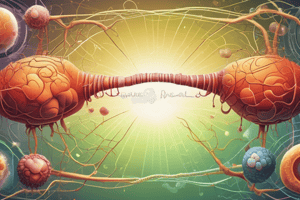Podcast
Questions and Answers
What molecule is produced when ATP is broken down?
What molecule is produced when ATP is broken down?
- ATP (Adenosine Triphosphate)
- NADH (Nicotinamide Adenine Dinucleotide)
- ADP (Adenine Di Phosphate) (correct)
- AMP (Adenine Monophosphate)
ATP is immediately required by the cell after it is produced.
ATP is immediately required by the cell after it is produced.
False (B)
What process breaks down glucose to produce ATP?
What process breaks down glucose to produce ATP?
respiration
ATP can be used to build a molecule of __________.
ATP can be used to build a molecule of __________.
Match the following terms with their descriptions:
Match the following terms with their descriptions:
Flashcards
ATP
ATP
A molecule that stores and releases chemical energy within cells.
Respiration
Respiration
The process by which cells break down glucose to release energy.
ADP
ADP
A molecule formed when ATP releases energy.
Inorganic Phosphate
Inorganic Phosphate
Signup and view all the flashcards
Energy Release in Respiration
Energy Release in Respiration
Signup and view all the flashcards
Study Notes
Role of ATP
- When glucose is broken down during respiration, energy isn't always needed immediately.
- This energy is used to build ATP.
- ATP stores chemical energy.
- ATP releases energy when needed by the cell.
- ATP breaks down into ADP (Adenine Diphosphate) and an inorganic phosphate.
- Energy released by ATP breakdown fuels various cellular processes.
Cellular Processes Fueled by ATP
- Muscle cell contraction
- Active transport
- Cell division
- Protein synthesis
- Nerve impulse transmission
Studying That Suits You
Use AI to generate personalized quizzes and flashcards to suit your learning preferences.
Related Documents
Description
This quiz explores the role of ATP in cellular respiration and its importance in various cellular processes. You will learn how ATP stores and releases energy, as well as its impact on functions like muscle contraction and protein synthesis.




